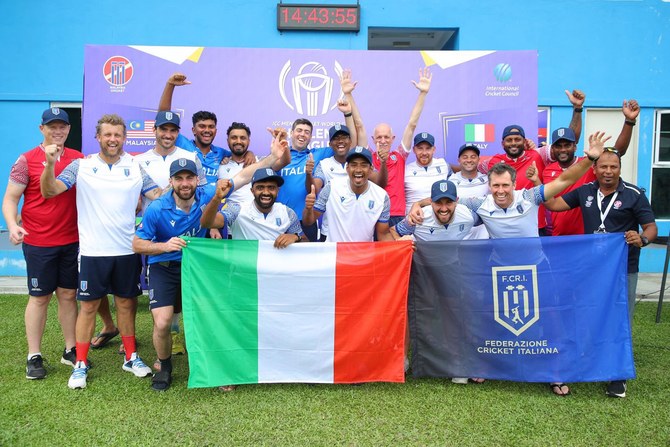“They play cricket there, really?” This is a common refrain when certain countries are mentioned in the same breath as cricket.
Actually, the list of such countries is long. The International Cricket Council has 12 full members who qualify to play official Test matches, whereas there are 96 associate members.
This is roughly half the number of countries which are members of the UN and leaves plenty of scope for the quizzical response: “They play cricket there, do they?” Saudi Arabia is one such country, Thailand is another, along with Greece.
In the last week, I have been met with incredulity when I have dropped into conversations that Italy’s men’s cricket team have been doing well recently. This at a time when its football team was knocked out of Euro 2024 at an early stage.
Between June 9 and 16, the Italian men’s cricket team participated in the 2026 ICC Men’s T20 World Cup Sub Regional Europe Group A Qualifier tournament, involving 10 teams. They were undefeated and handsomely beat Romania by 160 runs in the final. The team will progress to the final stage of European qualification to be held in 2025. Currently, they are ranked 29th in the ICC T20I rankings. Saudi Arabia is 32nd.
Italian cricket looks to be ascendant. It has not always been that way. This has been chronicled in two books authored by Simone Gambino, a past chairman of the Italian Cricket Federation and now its honorary president. He has penned a fascinating story which he has graciously summarized for me in English, and that has informed much of this article.
It is thought that British merchants and sailors introduced cricket to Italian ports in the late 18th and early 19th centuries. There is even mention of Vice Admiral Horatio Nelson organizing a match in Naples in 1793.
Cricket became popular amongst the elite in Italy and flourished throughout the 19th century. In September 1893 the Genoa Cricket and Athletic Club was formed by a group of British emigrants, football being a secondary concern.
In 1899, another group of emigrants led by Herbert Kilpin of Nottingham founded the Milan Foot-ball and Cricket Club, AC Milan, to remind them of home.
This apparent focus on cricket was soon eclipsed by the rise of football, and later by the rise of fascism. Its refusal of all that was English, excluding football, meant that cricket disappeared, not to be reborn until after 1945.
This was driven by cricket-loving staff of embassies and international organizations. When these suffered staff cutbacks in the late 1970s, Gambino became involved in running Italian cricket, having developed a passion for the game through his London-based American grandfather.
On Nov. 26, 1980, he founded the Associazione Italiana Cricket. In 1984 the ICC created the affiliate status, Italy becoming the first beneficiary. Between then and 1987 four summer tours to London were undertaken by the Italian national team, mostly composing indigenous players like Gambino. Three more summer tours took place between 1990 and 1992 featuring an all-indigenous Italian youth team.
A tour of Italy in 1993 by the Marylebone Cricket Club enhanced the profile of Italian cricket. This was followed by an application for Italy to be elevated to ICC associate membership, achieved in July 1995. According to Gambino, “it was the beginning of the end of clandestinity.” He uses this designation because cricket had not been officially recognized.
The Comitato Olimpico Nazionale Italiano had ignored the AIC since 1980 but was preparing a bid for the Olympics to be held in Rome in 2004. Since ICC associate status brings financial support, suddenly the value of officially recognizing cricket to gain English-speaking votes at the International Olympic Committee conference became apparent.
Gambino was summoned by CONI and official recognition ensued on Feb. 28, 1997. The AIC was transformed into the current Federazione Cricket Italiana.
Accession to associate status unlocked requests by Italian citizens living abroad, mainly from Australia and South Africa, wishing to represent Italy at cricket. Under ICC rules of the time, they were not eligible. Only birth in the country and residency counted, not citizenship.
Tension grew between the FCI and the ICC on the issue, culminating in the 2001 ICC qualifying event for the 2003 Cricket World Cup. The ICC ruled that four Italian citizens were ineligible due to their non-residency in Italy.
Gambino withdrew the team from the tournament, officially readdressing the matter to an independent sports tribunal in Lausanne. Initially, the ICC accepted but then tried to divert the arbitration to London. Gambino refused to accept.
He was aware that the ICC had a much bigger problem. It wanted to join the Olympic committee. This would require adaptation of its eligibility rules to include citizenship. A compromise prevailed by which Italy was allowed to withdraw without sanction and the ICC undertook to fully revise its eligibility rules, which it did.
Having been the catalyst for change, Italy needed to take advantage. At that time, children of parents from the Indian subcontinent who had emigrated to Italy were barred from playing cricket for the country because they did not possess citizenship.
On Dec. 7, 2002, the FCI passed a rule that all minors who wished to play cricket should be recognized as if they were Italian citizens. CONI originally opposed the decision but withdrew after Gambino pointed out that playing cricket “is a civil liberty just as going to the theater and, furthermore, the parents of these youths are all taxpayers.” It has proved to be a controversial topic.
In the last 20 years, Italy’s men’s and women’s teams have climbed the ICC rankings and the game has spread all over the country, exposing a lack of proper playing facilities. Its current men’s national team is a mix of those with subcontinental backgrounds and those with citizenship acquired by descent.
The addition of several high-quality players in the second category has transformed results. This includes Wayne Madsen, born in South Africa, who has played almost 15 years in the English county championship, scoring over 15,000 runs. And Joe Burns who has played 23 times for Australia and is an opening batsman.
There is a fierce battle between ICC associate members to qualify for world cups. Italy is making a bold statement with its current strategy. Whether it can join the ranks of countries known for their cricketing prowess remains to be seen.
What it does possess is a rich, largely unknown and fascinating history on which to draw.



























